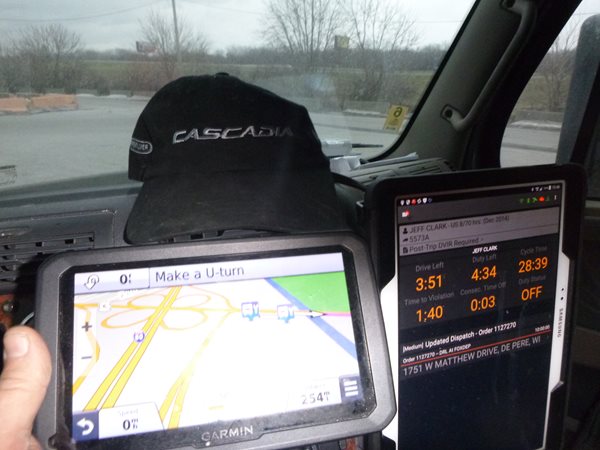
One of decisions drivers make everyday is how to best use our Hours of Service. Electronic logging has altered the decision making process. We can't get away with as much as we could on paper. On the other hand we are given more accurate information. Look at the screen shots from my picture. It gives you most of the information needed. It does not give all the information. That is where experience and technology have to work together to make the best decisions.
It was 254 miles to my destination I had 3 hours and 51 minutes of drive time left. My 14 hour clock had 4 hours and 34 minutes remaining. The 1 hour and 40 minutes was the time that I had left until I needed a 30 minute break. That is the information that my gadgets were giving me.
The rest of the information that you would need to know is as follows. The time was 16:00. My location was Lake Station, IN. I had a marker light out. We have a shop in Sturtevant, WI. That is on route and about 100 miles from my present location. After dropping my load, I would have to pick up an empty trailer and head back to our Green Bay terminal about 5 miles from there. After that I would be taking a 34 hour restart.
My options were to try to make it the 100 miles to the shop, and take a 30, while they fixed the light, or to take my 10 there and eliminate the need for the 30 minute break. Chances are that I could not make 100 miles in 100 minutes with rush hour Chicago in the way. I could take my 30 there in Lake Station and then go to the shop. I could even take a 10 hour break in Lake Station. The other option was to take a 2 hour break in Lake Station and then go up to the shop and take an 8 hour sleeper berth break. My goals were to make it home ASAP and get the light fixed.
My decision was to take a 2 hour break in Lake Station and then go to sleep in Sturtevant. Normally, I like to make it through Milwaukee. Taking a 2 hour break in Lake Station would eliminate that possibility. On the other hand I would be going through Milwaukee at about 05:00. Taking a 2 hour break in Lake Station allowed me to take a shower at the Flying J. Then I went to the TA for dinner. This allowed traffic in Chicago to die down.
The shop could not get to my trailer right away. That was not a problem. I dropped the trailer went to bed and picked it up in the morning. Taking the split meant that I could eliminate the 30 minute break. Chicago traffic would die down before I got there. Milwaukee was a breeze. I did not drop a trailer with a light out for the next driver. When going through the hours of service gymnastics, consider all of your options.